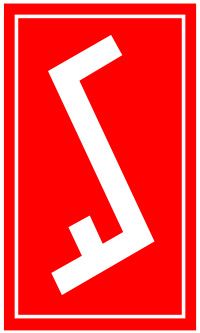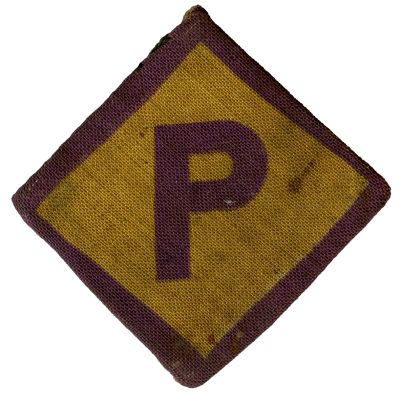The Rodło emblem

After the foundation of the Union of Poles in Germany (the umbrella organisation of Poles in Germany) in 1922, the leadership decided to introduce its own emblem. The German authorities had forbidden Polish organisations to use the colours of Poland on their flags and the symbol of the white eagle. A competition to find a suitable emblem was launched on several occasions but none of the entries resulted in a satisfactory solution. Nonetheless the General Secretary of the Union of Poles, Dr. Jan Kaczmarek, refused to give up on the idea. Kaczmarek originally came from a miner's family and was one of the first academics from amongst the Poles in Westphalia. The preparations for the tenth anniversary of the Union of Poles in Germany provided a welcome excuse to return to the question of the emblem. Stefan Murek, the editor of "Polak w Niemczech" ("The Pole in Germany") suggested the course of the River Weichsel as a leitmotif. In order to avoid any similarity with runic characters and/or the Nazi swastika Dr. Kaczmarek suggested placing Cracow, the cradle of Polish culture. on the course of the river.
A young graphic designer and student at the Warsaw Academy of Arts, Janina Kłopocka, was commissioned to create a design. She submitted several drafts before one of them was finally accepted by the Central Committee and its President Pastor Bolesław Domański. The name of the future emblem was left open, and the committee invited Edmund Jan Osmańczyk a young editor at the “Młody Polak w Niemczech” (“The Young Pole in Germany”), to make a suggestion. Osmańczyk came up with a neologism, “Rodło”, a compression of two words, “ROdzina”(family or tribe) and “goDŁO”(coat of arms). The new name met with general agreement. The artist’s final draft showed the course of the Weichsel, the silhouette of Wawel castle and the name of Cracow in front of a red and white background. Beneath it were the words: "We are Poles. We belong to the Polish Nation, whose cultural cradle is Cracow and its faithful river the Weichsel. These two powerful elements unite our Rodło, which is neither a coat-of-arms nor an emblem, but a symbol of our origin and attachment to the whole Polish Nation and its spirit". The new emblem spread very quickly. It was set on the flag of the Union and the members were given badges with the new symbol of the Union.
The new emblem was used for the first time in public during the "2nd Congress of Poles Abroad" in Warsaw, which took place in August 1934. This was the first manifestation of Poles from different parts of Germany and a demonstration of their attachment to their mother country. The Poles from Germany appeared in public as a single group with their own original flags "wed" with the Weichsel on 5th August. This event received wide press coverage, some of which was misunderstood. A few editors confused the name "Rodło" with a Slav hook plough called "Radło". Around 3000 persons took part in the so-called "Wedding with the Weichsel", during which they processed through the centre of Warsaw carrying the flags of the Union. The flags contained the new emblem and the place name of each local group belonging to the Union. When the procession reached the banks of the river the flags were solemnly lowered into the water. It was not long before the Poles in Germany were called "Rodlaki".
In a publication called "Na Śląsku Opolskim" issued by the Silesian Institute in Katowice in 1937 the author Stanisław Wasylewski described the Rodło and its integrating significance for the Poles in Germany in the following terms: "It was a fine idea to unite all the Poles who lived in the German state beneath a single motto in a similar manner as the Polish knights had been united in their struggles beneath the battle cry "Polkoza" or "Jastrzębica". "Rodło" now became a third cry. The new word had soon established itself in everyday language and many people were surprised by its ancient sounding name. There were even people who searched their dictionaries in vain to try to establish its origin and meaning. But there had never been a "Rodło" beforehand. It was a completely new and striking invention. The Rodło emblem was also used by a variety of young people’s organisations in Germany, one of which was on the lily of the Polish boy scouts in Germany. The Rodło song was written in 1935:
Od wieków wszystko zwyklim kłaść w ofierze,
od wieków walczyć co dnia wciąż na nowo,
o okruch prawa, polskie „W Boga wierzę”,
o polską duszę, każde polskie słowo.
Idziemy z siłą co płynie z słuszności,
nam walka hartem, a siłą wytrwanie
i przysięgamy na swych Ojców kości-
o sprawę walczyć nigdy nie ustaniem!
Jesteśmy Polakami!
I tego żadna moc nie zmieni!
Bóg z nami, Sprawa z nami,
Bóg nam wiarą serca rozpłomienił!
Rodło królewskie mamy!
Jesteśmy Polakami!
The author of these lines was Edmund Jan Osmanczyk and the music was composed by Pazia Kaczmarek. The "Rodlo Hymn" was written in 1938. Its author was Franciszek Jujka. It was sung for the first time by a united Polish choir at the Congress of Poles in Germany in Berlin on 6th March 1938:
Nam Bóg powierzył Ojców ziemicę,
pruskie jeziora śląskie kopalnie oraną sochą zroszoną krwią.
Dał znak rodowy Złoto w skiełany, Westfalii świat!
Wszystkich nas łączy Wisłę rodzicę,
co karmiła nykrynica swą nie rozerwalnie.
Matczyne znamię rodzony brat.
Dziejowej chwały postawił gontynę
Więźnią serdeczną splećmy rodzinę.
U Wisły źródeł wawelski gród.
Rodło niech łączy nas Hartujmy dusze na znój i trud.
Rodło niech łączy nas w mężną drużynę!
Polski my Naród, polski my lud!
W mężną drużynę!
Polski my Naród, polski my lud!
The creation of a new emblem was, without doubt, an integrating factor in the Polish minority in Germany. The use of a separate emblem differentiated the Poles from the Germans, who had adopted the Swastika and the Hitler salute after 1933. It demanded great courage from the Poles to use the Rodlo emblem, especially when acts of persecution increased in the late 1930s. Edmund Osmanczyk expressed the atmosphere reigning in these years very precisely in the following words: “It goes without saying that it [the use of the Rodlo emblem] demanded great courage, which was paid for by many in the form of imprisonment or internment in a concentration camp in 1939. It is a testament to history that until September 1939, not only in Westphalia and the Rhineland, but also on the Oder from Ratibor to Stettin, in the whole of the Oder region and East Prussia the autochthonic Polish population manifested its affiliation to the cradle of the Polish nation and culture during the dark years of the Third Reich”.
Krzysztof Ruchniewicz, April 2014


